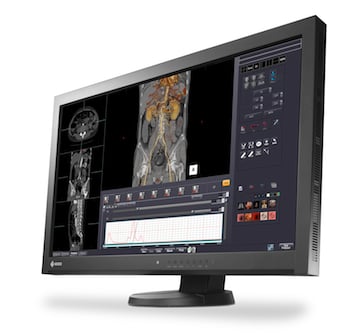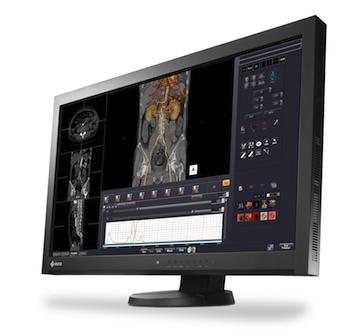
This article appeared as the introduction to the Flat Panel Displays comparison chart.
As hospitals and imaging centers are transitioning more from film to digital imaging systems, the monitors displaying those images become a critical part of the equation. Accordingly, the DICOM standard developed by the American College of Radiology (ACR) and the National Electrical Manufacturers Association (NEMA) include a complete section (Part 14) relating pixel values to displayed luminance levels and defining a grayscale standard display function (GSDF) to help achieve accuracy and consistency.
As noted in the section’s foreword, “A digital signal from an image can be measured, characterized, transmitted and reproduced objectively and accurately. However, the visual interpretation of that signal is dependent on the varied characteristics of the systems displaying that image. Currently, images produced by the same signal may have completely different visual appearance, information and characteristics on different display devices.
“In medical imaging, it is important that there be a visual consistency in how a given digital image appears, whether viewed, for example, on the display monitor of a workstation or as a film on a light-box,” the standard continues. “In the absence of any standard which regulates how these images are to be visually presented on any device, a digital image which has good diagnostic value when viewed on one device could look very different and have greatly reduced diagnostic value when viewed on another device. Accordingly, PS 3.14 was developed to provide an objective, quantitative mechanism for mapping digital image values into a given range of luminance.”
The standard further states, “An application which knows this relationship between digital values and display luminance can produce better visual consistency in how that image appears on diverse display devices. The relationship that PS 3.14 defines between digital image values and displayed luminance is based upon measurements and models of human perception over a wide range of luminance, not upon the characteristics of any one image presentation device or of any one imaging modality. It is also not dependent upon user preferences, which can more properly be handled by other constructs, such as the DICOM Presentation Lookup Table.” 1
Today, most medical image display systems are calibrated to match their grayscale characteristics with the GSDF.
Physicists’ Guidelines for Digital Displays
The American Association of Physicists in Medicine (AAPM) also developed guidelines, (TG18), for digital medical imaging displays. As noted in the Executive Summary, 2 AAPM said, “The adoption of digital detectors and picture archiving and communication systems (PACS) has provided healthcare institutions an effective means to electronically archive and retrieve radiological images. Medical display workstations, an integral part of PACS, are used to display these images for diagnostic and clinical purposes. Considering the fundamental importance of image quality to the overall effectiveness of a diagnostic imaging practice, it is vitally important to assure that electronic display devices (also termed softcopy displays) do not compromise image quality.”
AAPM’s TG18 guidelines, published in 2005, include visual, quantitative and advanced testing methodologies for primary- and secondary-class display devices. They cover characteristics including reflection, geometric distortion, luminance, the spatial and angular dependencies of luminance, resolution, noise, glare, chromaticity and display artifacts. They also recommend the use of specific test patterns for performance evaluation of display devices in order to facilitate comparisons of measurements.
AAPM concludes its summary of the guidelines with additional recommendations: “Due to hardware variability and degradation over time, it is important to assure that a medical display system is appropriate for the intended medical application and that its performance is stable over time. Acceptance testing and quality control testing of medical display devices are essential requirements for high-quality medical practice.”
References:
1. PS 3.14-2009 “Digital Imaging and Communications in Medicine (DICOM) Part 14: Grayscale Standard Display Function.” National Electrical Manufacturers Association, Rosslyn, Va.
2. Samei E, Badano A, Chakraborty D, Compton K, Cornelius C, Corrigan K, Flynn MJ, Hemminger B, Hangiandreou N, Johnson J, Moxley-Stevens DM, Pavlicek W, Roehrig H, Rutz L, Shepard J, Uzenoff RA, Wang J, Willis CE. “Assessment of display performance for medical imaging systems: Executive summary of AAPM TG18 report.” Medical Physics 32(4):1205-1225, 2005.
For more information on the information cited, visit www.nema.org or www.aapm.org.



 December 01, 2025
December 01, 2025 









